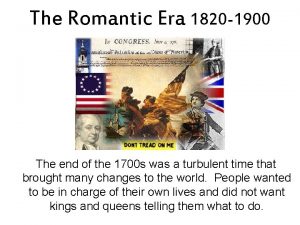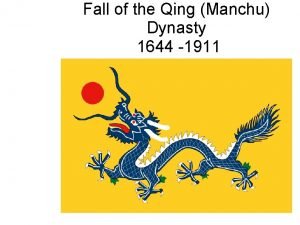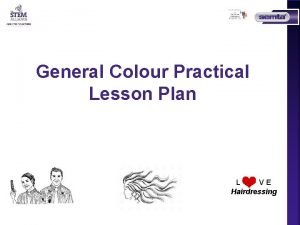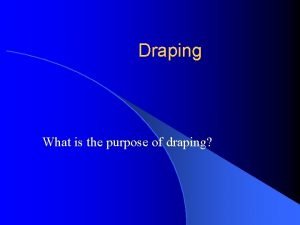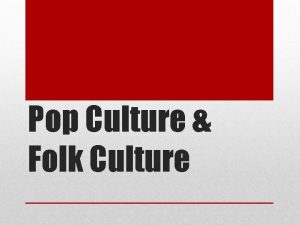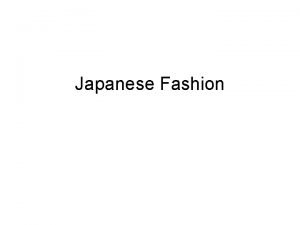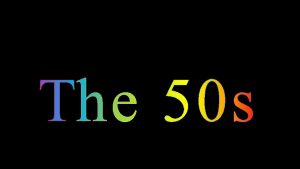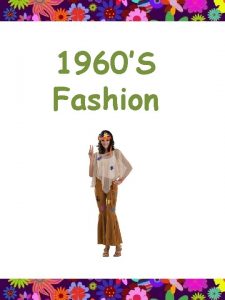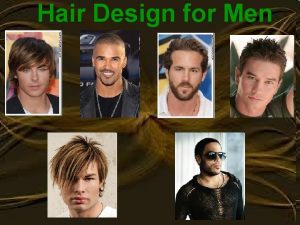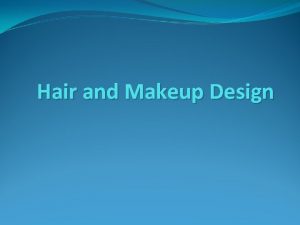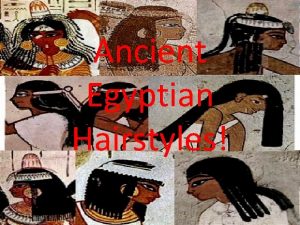HAIRSTYLES FROM CULTURE TO FASHION STATEMENT Whats hairdressing


























- Slides: 26

HAIRSTYLES FROM CULTURE TO FASHION STATEMENT

What’s hairdressing? It’s the art of arranging hair

Hairstyles along history: social and cultural significance It’s been a signifier of: • Class • Gender • Ethnicity • Authority and Power

General Overview 1 Necessity to cut or confine the hair to keep it out of the way 2 Personal adornment

3 Status and Age - Primitive men: fastened bones, feathers and other objects. Why ? Impress and Frighten Enemy - Noble Rank: long hair. - Noble Rank after the conquest: short hair

- Boys in ancient Greece cut their hair - Hindu boys shaved their heads when they reached adolescence

4 Religious Significance - the shaved heads of Christian and Buddhist monks: renunciation of the world; - England in the 17 th century: cropped hair and long curling locks

5 Last changes in hairstyles - Influence of fashion * Changes through the years * Class * Today: women and men in all classes can choose the style and colour of their own hair, or of a wig I (always, normally) like to keep my hair short/long I like to put my hair into a pony tail/twist/pig tails (often, sometimes) I like it curly/straight/with-without gel I like my hair to look spiky/soft/unkempt

History of Hair From 3000 BC to Present Day http: //www. ukhairdressers. com/history%20 of%20 hair. asp

Egypt • Noblemen and women: hair clipped close to the head • Curly black wigs donned for ceremonial occasions (women’s wigs were often long and braided, adorned with gold ornaments) • Men’s faces: shaved

Greece • Women’s hair: long and pulled back into a chignon (bun). May dyed their hair red with henna and sprinkled it with gold powder, often adorning it with fresh flowers or jewelled tiara’s. • Men’s hair: short and sometimes shaved.

Rome • Like Greek styles: - Upper classes: use of curling irons and gold power. Women often dyed their hair blonde or wore wigs made from hair of captive civilization slaves. - Later: more ornate hairstyles with hair curled tight and piled high on the head. Hairdressing: more popular slaves attended upper classes public barber shops visits

The East • Hair hidden in public: - Men: turban or fez - Women’s hair: veil - Men and women: local public baths

China • Unmarried Chinese girls: long hair • Women: hair combed and tied up into a knot at the nape. • Men: front of head shaved back of head with long and braided hair, tied with black silk

Japan • Males: front of the head shaved back of head with hair pulled tightly into a short stiff ponytail. • Women: Medieval period: long and loose 17 th century: more styled Swept up from the nape of the neck and adorned with pins and jewelled combs. Geisha

Africa • Many tribes, so many hairstyles Easters Tribes: desert Western Tribes: tropical rainforest • African Masai • Mangbetu • Mursi tribes

America • Native American Indians from: – East Coast – Great Plains – Central America, Mexico (Aztec) – Central America, southern Mexico (Maya) – Further South (Incas)

The Western World

15 th Century (Renaissance period) • Upper class ladies

16 th Century • Queen Elizabeth: set the trends. – white face powder and red wigs.

18 th Century • Elaborated wigs, mile-high coiffures and highly decorated curls. • White powdered wigs with long ringlets. • Big hair

Victorians • Puritanical line • Hair

1920 • Women: more free more independent. Theatre and Cinema • Emergence of short, bobbed and waved styles • Men’s hair remained short, but using brilliantine and highly perfumed oils.

1980 • The “Age of Excess”: more freedom of choice in styles and trends. • A good hairdresser was an essential part of this woman’s life. This woman’s hairstyle reflected ‘control’, a busy work life

Modern Hairdressing Procedure

What does this show us? • Different people throughout the world have different ideas of what beauty is • One is not necessarily better than the other • Your hairstyle is not the only way to look great TREAT EVERYONE EQUALLY AND APPRECIATE DIFFERENCES! Images taken from http: //www. shutterstock. com/
 Jrotc girl hair
Jrotc girl hair 1820 hairstyles
1820 hairstyles 1600 hairstyles
1600 hairstyles China and imperialism
China and imperialism Hairdressing lesson plans
Hairdressing lesson plans What material is to be used in draping the client?
What material is to be used in draping the client? Hairdressing dermatitis
Hairdressing dermatitis Hairdressing tool
Hairdressing tool Material culture and nonmaterial culture
Material culture and nonmaterial culture Individual culture traits combine to form culture patterns.
Individual culture traits combine to form culture patterns. Batch culture vs continuous culture
Batch culture vs continuous culture Continuous culture and batch culture
Continuous culture and batch culture Characteristics of collectivism
Characteristics of collectivism American vs indian culture
American vs indian culture Uses of selenite f broth
Uses of selenite f broth Folk culture and popular culture venn diagram
Folk culture and popular culture venn diagram A sub-culture group
A sub-culture group Popular culture examples
Popular culture examples Stab and stroke culture
Stab and stroke culture Folk culture and popular culture venn diagram
Folk culture and popular culture venn diagram Adaptive culture from inert culture
Adaptive culture from inert culture Stab culture and stroke culture
Stab culture and stroke culture Lawn or carpet culture
Lawn or carpet culture Quality culture
Quality culture Surface culture deep culture and esol
Surface culture deep culture and esol What is pop culture definition
What is pop culture definition Organizational culture definition by authors
Organizational culture definition by authors

